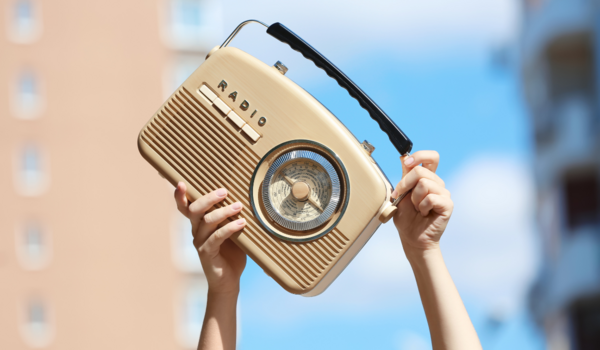Let’s face it: Radio branding needs to be catchy. Between the radio jingles we happily sing along to and the station logo stickers we proudly place on our cars, radio branding must not only capture the audience’s attention but also create a community of loyal listeners. Fortunately, an effective radio branding strategy can check both those boxes—and then some!—for new broadcasters.
Radio branding is what makes a broadcast instantly recognizable to its listening base. From the tunes that hooked us to the graphics that caught our attention, it’s often branding that shapes a radio station’s distinct identity. In today’s post, we’ll take you on a crash course through radio branding, complete with five radio station branding ideas to inform your branding strategy.
Main Takeaways:
- A solid radio branding strategy is integral to shaping the identity of a broadcast channel and attracting listeners that align with the station’s target demographics.
- A broadcaster should ask themselves several questions before beginning a radio station branding strategy, such as what is their mission and desired audience.
- A radio branding guide consists of three primary components, which are the radio station’s specific name, unique graphic elements, and distinct sound profile.
Importance of a Good Radio Branding Strategy
Before we dive into the importance of radio station branding, specifically, let’s take a quick detour to define branding in general. Branding refers to the unique assets that distinguish one company or entity from another. In a radio branding strategy, those assets typically include a station’s distinct name and logo, the colors and icons used in the advertising materials, and of course, their sound.
Think of your favorite internet or local FM radio station—they have a clear identity. You have a general idea of what to expect when you tune in, you’re familiar with the on-air personalities (even if you have no clue what they look like!), and you might even be able to pick their logo from a lineup. Defined expectations and unmistakable programming: these are the effects of powerful branding!
How To Define Your Radio Branding Strategy
Now that you can define radio station branding, you can craft your own radio branding strategy. This is the time to nail down your station’s identity. To create your identity as a radio station, you need to answer a few questions. Perhaps one of the most important questions to ask yourself when creating an internet or local radio station is, “Who are you?” Or rather, “who” do you want your station to be?
So, Who Are You?
First things first, who are you? Are you an academic historian who loves all things vintage or a sports enthusiast who prefers to hit the field? What kind of music do you like? Consider how you listen to your favorite radio stations and why certain programming stands out to you. Then, ask yourself, is that the same listening experience you want to provide your audience?
Why Are You Creating This Station?
Now that we’ve covered the ‘who,’ let’s tackle the ‘why.’ Every radio branding strategy contains a mission statement or a quick blurb that describes why a broadcaster or internet personality chose to bring a radio station to the market. As you craft a branding strategy, figure out your unique ‘why.’
It could be that you have a vast collection of music from the sixties that you want to share with others because you can’t quite find the perfect station that plays all of your favorites. Maybe your hobby is finding all the latest and greatest indie songs, and you’d like to help introduce them to the world.
Or, you could be incredibly knowledgeable about something or have a particular sense of humor that you think others would potentially resonate with. Bottom line, there’s a reason you’re thinking about starting a station. What is it? At the heart of that reason lies your mission statement.
What Do You Want To Share?
Once you’ve settled on a basic mission statement, you can move to your vision statement. A vision statement is a quick blurb that answers the question of what you want to share. You can argue that this is essentially the same question as above, but this goes beyond the creation of your station.
Yes, you want to share the best rock ‘n’ roll on the planet with your audience, but what else?
Is it going to be all rock all the time? Are there causes you’re passionate about? Are you going to be funny or serious? Will you share news? If so, will it be national news, only feel-good stories, or just local news? Ultimately, you may want your station to share more than just one genre of music, and that information is crucial to your station's identity.
Who Is Your Audience?
This one covers a few bases, and it’s easiest if you come up with a marketing persona. A marketing persona is a fictional representation of an actual listener. Your persona may be defined by a number of things, including basic demographics (age, location, occupation, etc.) as well as shared interests.
In order to deliver the most relevant and useful audio content to your audience, you need to know who they are. What music do they prefer? Are they interested in music discovery or hearing music they know? Do they care about the news? Do they have other shared interests? Where do they live? Are they a global, national, or local audience? Answer these questions to define your audience.
What Sets You Apart From the Others?
There are tons of radio stations out there. What do you offer that others don’t? It could be the latest local news, the next big hits from up-and-coming artists, DJs with personalities that shine through the digital airwaves, or ways to interact with listeners, like fun contests with awesome prizes.
Maybe you even have a seasonal theme, like a Halloween radio station! Think about what unique value you bring to listeners—that’s what sets you apart and makes you stand out from competitors. These specific differentiators should be the focal point of your radio branding strategy.

Creating Your Radio Station’s Brand
Once you know ‘who’ you want your station to be, you can begin branding your broadcast. In order to make this process easy, especially as you continue growing your brand, consider creating a brand style guide to ensure your branding is consistent across all instances, like your station profile page, social media, and website.
It’s helpful to think of a style guide as a road map to your radio branding, with exact specifications for key branding elements, like your mission and vision statements. This also includes creating your station name, logo, cover art, description, and more. As you craft a recognizable identity for your radio brand, follow these three steps.
Name Your Radio Station
Your station name is integral to the discoverability of your broadcast. Your listeners—and voice assistants, like Amazon Alexa—will likely mispronounce or forget tongue twisters and overly complicated names. So, aim for something clear and instantly recognizable to enhance listener awareness, but also strive for a memorable and unique name to strengthen your brand.
To choose a name for your radio brand, consider the key characteristics of your programming, like the music you play or values you support. Determine which words fit your personality and the type of media you promote, such as ‘vibrant,’ ‘eclectic,’ or ‘calming.’ Use these words to brainstorm a solid station name and to write an engaging description of your radio brand to place in your style guide.
Create a Visual Identity
Visual identity refers to the image you promote for your radio brand or the visual elements that make your station stand out from the rest. Like your station name, your visual identity should be distinct and easily recognizable. It should also be attractive and consistent across various channels, such as your website and social media. A key component of your visual identity is your station logo.
Your logo is the face of your radio brand. Because it’s the first thing listeners see when finding you online or in the Live365 directory, select design elements that represent your programming style—like retro fonts and icons for a 1970s throwbacks station. Another radio station logo tip is to select visual elements that will print well on branded merchandise like bumper stickers and apparel.
Craft Your Sound Brand
Sound or audio branding is the last but certainly not least component of a radio branding strategy. After all, what’s a radio station without the audio listeners hear? To master your station’s sound brand, tackle your radio imaging first. Radio imaging refers to the sound effects and tunes, such as jingles and voice overs, that have been designed to individualize and brand your radio station.
It's important to remember that your branding and programming need to be in sync. In other words, if you decide that your station is going to be branded as a ‘rock only’ station, then your programming needs to reflect that. Ensure that everything from your music choices to your on-air presenters and even advertisers has a similar vibe that’s appropriate for your station’s sonic brand.

5 Radio Station Branding Ideas and Examples
What’s a guide to radio branding without a few radio station branding ideas to inspire you? We’ve gathered some of the most well-branded Live365 stations to give you a masterclass in successful branding. Take a look at these five radio branding examples to make your station truly memorable!
That 70's Channel
As the name might suggest, That 70’s Channel is home to the biggest music hits of the 1970s… that’s why we think it’s such perfect branding! With a catchy, clear, and pop-culture-relevant name, That 70’s Channel sets instant listener expectations for what they’ll hear when tuning in. The station also has distinct visual branding, featuring groovy fonts and bright colors that capture the 70’s vibe.
Aardvark Blues FM
Live365 listeners love the Aardvark Blues FM radio station for its fun logo, which features the face of an aardvark wearing some pretty cool shades. Not only is the logo immediately recognizable to the audience, but it’s also something loyal listeners would be happy to stick on the bumper of their car (at least we would be!). The visual identity of Aardvark Blues FM perfectly suits the station’s mood and the sound brand it’s developed.
Now Wave Radio
When it comes to radio stations with a robust brand style guide, Now Wave Radio takes the cake. The station’s name is a slight pun, tying the ‘Wave’ part to music genres like New Wave, Dark Wave, and Synthwave and making the audio branding totally obvious. Now Wave Radio also features an attractive color scheme of vibrant blues and oranges to further capture the brand’s visual identity.
Great Old Time Radio
If your radio programming is less music-focused and more talk-heavy, you’ll likely enjoy the inspiration powered by Great Old Time Radio. As you might imagine, Great Old Time Radio provides a no-fuss, old-time listening experience that centers on short runs, regional shows, and never-heard-before mystery and comedy programs. The chosen visual elements are also simple, centering on a classic microphone and keeping in line with the old-time broadcaster feel.
Smells Like Byron Center
The branding of the Smells Like Byron Center radio station is an awesome example of combining a target demographic with desired radio programming. As a play on words on the famous Nirvana song, “Smells Like Teen Spirit,” this station spins a collection of alternative and grunge music. However, the name is also a nod to the station’s physical location in Byron Center, Michigan.
Bring Your Radio Brand to Life with Live365
Radio branding isn’t just a nice-to-have for stations; it’s a must-have to succeed. With the proper radio branding, your station can not only capture the attention of brand-new listeners but also maintain a steady audience base. Plus, a solid radio branding strategy helps create a reliable brand style guide to inform future marketing and advertising efforts for your radio station.
The best part? Now that you've decided on your branding, you can move on to implementing your branding! This means completely filling out your station profile page, creating or updating your website, and promoting your station on social media, all according to your brand style guide. Ready to start your own station? Contact one of our Product Consultants or visit our website today!
Radio Branding FAQ
How do you brand a radio station?
Radio station branding includes a memorable name, unique visual identity, and recognizable sound profile. The best way to brand a radio station is to define why you are creating the broadcast in the first place, so you can create audio and visual assets that align with your target audience and goals.
What is a radio marketing strategy?
A radio marketing strategy is a plan of action to promote a radio station through various channels, such as online platforms like social media sites, on-air segments, and partnerships with other radio personalities. A radio marketing strategy helps to improve the general reach of a station, generate genuine relationships with listeners, and increase the total size of the audience base.
Why is it important for a radio station to have a consistent brand?
A radio station must have a consistent brand to be discoverable and recognizable by listeners. A strong brand sets a radio station or host personality apart from other programs. Likewise, remaining consistent makes it easier for listeners to identify a station’s brand on various platforms.
Discover thousands of free stations from every genre of music and talk at live365.com/listen. Keep up with the latest news by following us on Facebook (Live365 Official and Live365 Broadcasting) and Twitter (@Live365 and @Broadcast365)!
Article Image: Rawpixel via DepositPhotos.



